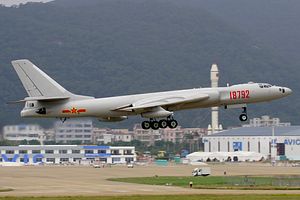Last week, as my colleague Franz-Stefan Gady discussed, the Chinese People’s Liberation Army-Air Force (PLAAF) flew six Xian H-6K long-range heavy bombers through the Miyako Strait, a strategically vital international air and waterway that cuts through Japan’s Ryukyu island chain, separating the East China Sea from the Pacific Ocean.
“China’s air force over the past week conducted multiple drills far out at sea, with H-6K bombers and many other types of aircraft flying through the Bashi Channel and Miyako Strait, testing actual battle capabilities over the sea,” PLAAF spokesman Shen Jinke was quoted as saying by Chinese state-run media.
For the PLAAF and the People’s Liberation Army-Navy, the Miyako Strait, along with the Bashi Channel, is one of two strategically vital geographical chokepoints that form entryways into the wider Pacific Ocean. They sit along what Chinese strategists have long regarded as the “first island chain” — a range of features running from the Kuril Islands in the North to the archipelagic Southeast Asian states of the Philippines and Indonesia in the south. Given that most states along this chain are either friendly to or allied with the United States, bypassing the first island chain is central to the PLAN and PLAAF’s plans to become more expeditionary forces.
Reacting to concern in Japan, Ren Guoqiang, a Chinese Ministry of Defense spokesman, said there was no cause for alarm with this flight and that “relevant parties” (meaning Japan) should “get used to it.” Ren said that the PLAAF bomber transit of the Miyako Strait was a routine drill and a legal transit. “It is legitimate for Chinese military planes to fly through the strait, and more similar training will be conducted on the high seas as needed,” Ren said.
The suggestion that Japan get used to these types of transits by the PLAAF and PLAN is not an empty comment — it’s reflective of China’s plans, as it develops a blue water, carrier-centered navy, to make the Western and Northern Pacific Ocean a regular area of operation.
In 2016, the PLAN and PLAAF conducted regular drills through the Miyako Strait and the Bashi Channel, culminating in the December 2016 drills by the Liaoning carrier strike group. For the first time, the Liaoning entered the Western Pacific through the Miyako Strait before traveling southward and entering the South China Sea through the Bashi Channel. As I wrote in December 2016, that drill underlined the growing importance of mastering the first island chain for the PLAN.
Meanwhile, Japan can’t help but sense that regular PLAN and PLAAF activities through the Miyako Strait and other choke points are now a fact of life.

































